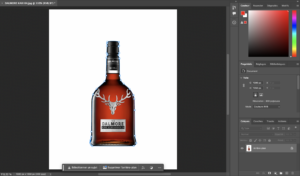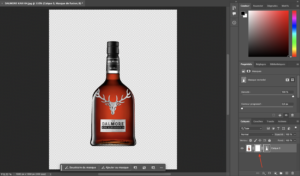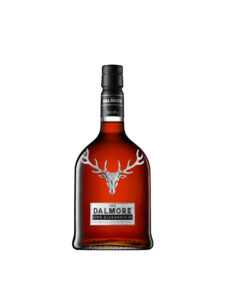Photo Clipping
In this article :
Photo clipping is an essential step in photo retouching, widely used across various industries such as e-commerce, advertising, and visual content creation. This technique allows you to isolate a subject from its background to either highlight it or incorporate it into diverse graphic compositions. Beyond its technical aspect, photo clipping opens the door to endless creative and commercial possibilities.
Understanding Photo Clipping
Photo clipping involves separating an element from its background to make it independent. This process is particularly useful when it comes to standardizing visuals or adapting them to various contexts. For instance, a product clipped from its background can be integrated into a more complex composition, offering complete flexibility to designers and marketers. In e-commerce, for example, this technique has become essential for standardizing product images, while in the field of retouching, it plays a key role in perfecting visuals intended for ambitious advertising campaigns.
Methods for Successful Photo Clipping
Each image requires an approach tailored to its complexity. Here are the main techniques used by professionals:
Manual Clipping: Precision Above All
The manual method is ideal for images with complex outlines, such as hair or irregular elements. Clipping in Photoshop, particularly using the Pen tool, allows for selections with extreme precision. While time-consuming, this technique offers full control over the final result.
 Manual Photo Clipping of a Dalmore Bottle
Manual Photo Clipping of a Dalmore Bottle
Automated Tools: Efficiency and Simplicity
Some tools offer automatic solutions that analyze contrasts and shapes to perform clipping in just a few clicks. These solutions are particularly suited for simple images or batch processing, although they may sometimes require manual adjustments to achieve a perfect result.
Using Layer Masks
Layer masks provide unmatched flexibility. By adjusting transparency and borders, it’s possible to preserve fine details, such as hair or transparent fabrics. This technique is often used for visuals requiring integration onto a new background or within a dynamic composition.
 Fusion Mask of a Dalmore bottle (red arrow)
Fusion Mask of a Dalmore bottle (red arrow)
Each method addresses specific needs. In all these cases, photo clipping is a crucial step, inseparable from the broader processes of photo retouching, where precision and technique adaptation play a central role in achieving an optimal result.
Key Steps to Optimize Photo Clipping
The success of a photo clipping process depends on a well-thought-out approach:
- Image Analysis: Determine the method to use based on the complexity of the edges and the contrast between the subject and the background.
- Pre-Cleaning: Adjust the levels and contrasts to facilitate selection. It’s also important to clean the image, as dust or imperfections may degrade the quality of the final image.
- Clipping and Adjustment: Use the appropriate tools (pen tool, quick selection, or layer masks) and refine the edges for a natural result.
- Adding Details: Once the background is removed, don’t forget to add shadows or reflections to enhance the realism of the image.
These steps are particularly crucial in specific cases, such as when removing the background of an image, for e-commerce visuals, integrating a product into an advertising banner, or creating complex montages where every detail matters. In these situations, a clean and professional result is essential to capture attention and enhance visual impact.
Applications of Photo Clipping in Different Sectors
E-commerce and Standardization of Visuals
In online stores, photo clipping is essential for showcasing products against uniform backgrounds. This ensures visual consistency, which is crucial for optimizing the user experience and reinforcing the brand identity.

 Final packshot of the Dalmore
Final packshot of the Dalmore
Advertising and Graphic Design
Advertising campaigns often require composited visuals where clipped elements play a central role. These visuals capture attention and help convey the message more effectively.
 Composite packshot of the Bowmore box
Composite packshot of the Bowmore box
Creation of Personalized Content
For social media or digital assets, photo clipping simplifies image customization. Content becomes more impactful, aligned with current trends where every detail matters. You can create a variety of visuals with clipped images, business cards, presentations featuring your images, the possibilities are endless.
Why Hire Professionals?
Although many tools are available for photo clipping, relying on professionals ensures an optimal result tailored to your specific needs. At Rétines, we master every step of the process, from analyzing your images to integrating them into your communication materials.
Our expertise in photo post-production allows us to meet the most demanding expectations, whether it’s for simple projects or visuals for large-scale campaigns.
Jérémy Carlo is the editorial director at Rétines, where he ensures the consistency and clarity of all content produced by the studio.
Our Clients
Let’s discuss
What we do for you at Rétines
Meticulous work, an organised project and fast delivery. And to achieve this, we mobilise the right resources in our teams at the right time.
01
Pre-production
Artistic and technical direction tailored to the project.
Relevant recommendations on content, form and resources.
02
Photo Shooting
Photos taken by our experienced photographers.
Production that’s controlled, efficient and tailored to the needs of the project, with nothing superfluous.
03
Retouching
Technique
Photographs magnified by our retouching team.
Post-production to meet the commercial challenges of the brief.

 Composite packshot of the Bowmore box
Composite packshot of the Bowmore box










